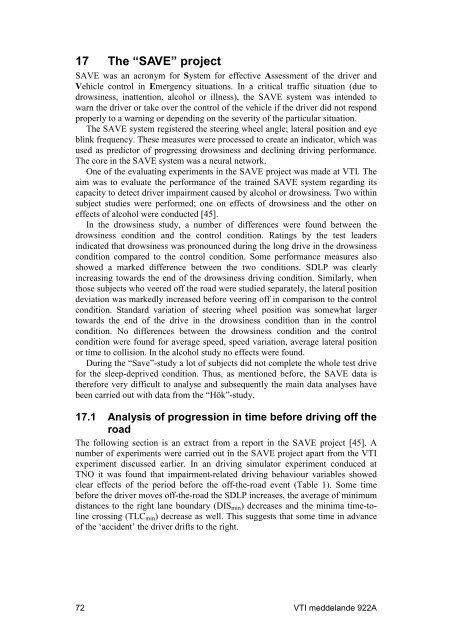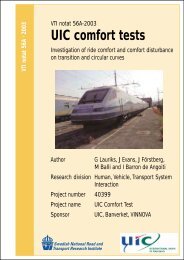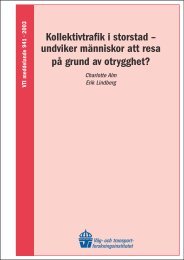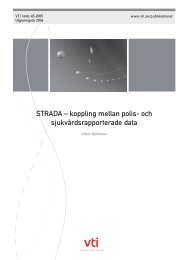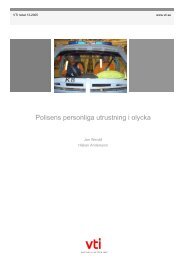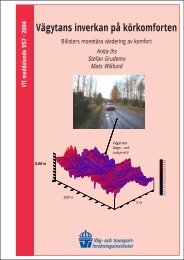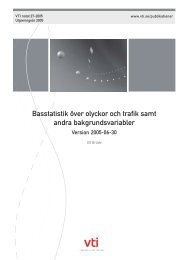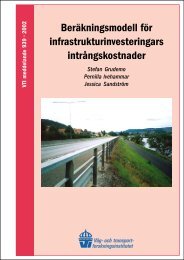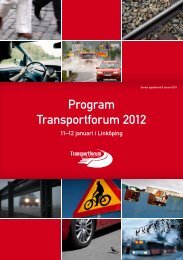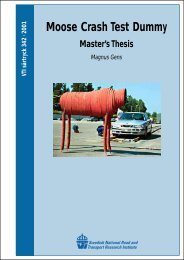Vehicle control and drowsiness - VTI
Vehicle control and drowsiness - VTI
Vehicle control and drowsiness - VTI
- No tags were found...
You also want an ePaper? Increase the reach of your titles
YUMPU automatically turns print PDFs into web optimized ePapers that Google loves.
17 The “SAVE” projectSAVE was an acronym for System for effective Assessment of the driver <strong>and</strong><strong>Vehicle</strong> <strong>control</strong> in Emergency situations. In a critical traffic situation (due to<strong>drowsiness</strong>, inattention, alcohol or illness), the SAVE system was intended towarn the driver or take over the <strong>control</strong> of the vehicle if the driver did not respondproperly to a warning or depending on the severity of the particular situation.The SAVE system registered the steering wheel angle; lateral position <strong>and</strong> eyeblink frequency. These measures were processed to create an indicator, which wasused as predictor of progressing <strong>drowsiness</strong> <strong>and</strong> declining driving performance.The core in the SAVE system was a neural network.One of the evaluating experiments in the SAVE project was made at <strong>VTI</strong>. Theaim was to evaluate the performance of the trained SAVE system regarding itscapacity to detect driver impairment caused by alcohol or <strong>drowsiness</strong>. Two withinsubject studies were performed; one on effects of <strong>drowsiness</strong> <strong>and</strong> the other oneffects of alcohol were conducted [45].In the <strong>drowsiness</strong> study, a number of differences were found between the<strong>drowsiness</strong> condition <strong>and</strong> the <strong>control</strong> condition. Ratings by the test leadersindicated that <strong>drowsiness</strong> was pronounced during the long drive in the <strong>drowsiness</strong>condition compared to the <strong>control</strong> condition. Some performance measures alsoshowed a marked difference between the two conditions. SDLP was clearlyincreasing towards the end of the <strong>drowsiness</strong> driving condition. Similarly, whenthose subjects who veered off the road were studied separately, the lateral positiondeviation was markedly increased before veering off in comparison to the <strong>control</strong>condition. St<strong>and</strong>ard variation of steering wheel position was somewhat largertowards the end of the drive in the <strong>drowsiness</strong> condition than in the <strong>control</strong>condition. No differences between the <strong>drowsiness</strong> condition <strong>and</strong> the <strong>control</strong>condition were found for average speed, speed variation, average lateral positionor time to collision. In the alcohol study no effects were found.During the “Save”-study a lot of subjects did not complete the whole test drivefor the sleep-deprived condition. Thus, as mentioned before, the SAVE data istherefore very difficult to analyse <strong>and</strong> subsequently the main data analyses havebeen carried out with data from the “Hök”-study.17.1 Analysis of progression in time before driving off theroadThe following section is an extract from a report in the SAVE project [45]. Anumber of experiments were carried out in the SAVE project apart from the <strong>VTI</strong>experiment discussed earlier. In an driving simulator experiment conduced atTNO it was found that impairment-related driving behaviour variables showedclear effects of the period before the off-the-road event (Table 1). Some timebefore the driver moves off-the-road the SDLP increases, the average of minimumdistances to the right lane boundary (DIS min ) decreases <strong>and</strong> the minima time-tolinecrossing (TLC min ) decrease as well. This suggests that some time in advanceof the ‘accident’ the driver drifts to the right.72 <strong>VTI</strong> meddel<strong>and</strong>e 922A


